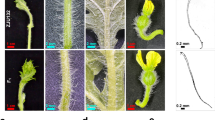Summary
The difference in colour intensity between flowers of sporogenic revertants of the white flowering lines W17 and W28 is caused by an incompletely dominant gene Inl. This gene is not linked to the anthocyanin gene Anl. In the dominant state Inl causes a 50% decrease in colour intensity of selfcoloured red flowers.
Chromatographic analysis of anthocyanins of plants homozygous recessive or dominant for Inl showed that the same anthocyanins are produced in both genotypes (cyanidin-3-glucoside and cyanidin-3-diglucoside). Anthocyanin synthesis starts at the same stage of development of the flower in both genotypes. When the bud reaches a length of approximately 45 mm, however, anthocyanin synthesis in the Inl Inl line slows down.
No influence of the gene Inl on the concentration of dihydroquercetin-7-glucoside in buds and flowers could be observed, which indicates that the influence of Inl on flower colour development is restricted to the last part of the biosynthesis of anthocyanins, i.e. the conversion of dihydroflavonols into anthocyanins.
In addition to Inl having a decreasing effect on flower colour intensity, evidence is produced that the gene Inl also influences the reversion frequency of unstable alleles of the gene Anl.
Similar content being viewed by others
Literature
Bianchi, F.; Cornelissen, P.T.J.; Gerats, A.G.M.; Hogervorst, J.M.W. (1978): Regulation of gene action in Petunia hybrida: unstable alleles of a gene for flower colour. Theor. Appl. Genet. 53, 157–167
Folch, J.; Less, M.; Sloane-Stanley, G.H. (1957): A simple method for the isolation and purification of total lipids from animal tissues. J. Biol. Chem. 226, 497–509
Harrison, B.J.; Fincham, J.R.S. (1968): Instability at the pal locus in Antirrhinum majus, III. A gene controlling mutation frequency. Heredity 23, 67–72
Kho, K.F.F.; Kamsteeg, J.; van Brederode, J. (1978): Identification, properties and genetic control of UDP-glucose: Cyanidin-3-0-glucosyltransferase in Petunia hybrida. Z. Pflanzenphysiol. 88, 449–464
Reddy, A.R.; Peterson, P.A. (1978): The action of the intensifier (IN) gene in flavonoid production in aleurone tissue of maize. Can. J. Genet. Cytol. 20, 337–347
Schram, A.W.; Timmerman, A.W.; Vlaming de, P.; Jonsson, L.M.V.; Bennink, G.J.H. (1981): Glucosylation of flavonoids in petals of Petunia hybrida. Planta 153, 459–461
Wiering, H. (1974): Genetics of flower colour in Petunia hybrida Hort. Genen Phaenen 17, 117–134
Wiering, H.; Vlaming de, P.; Cornu, A.; Maizonnier, D. (1979): Petunia genetics 1.- List of genes. Ann. Amélior. Plant. 29, 611–622
Author information
Authors and Affiliations
Additional information
Communicated by H. F. Linskens
Rights and permissions
About this article
Cite this article
Gerats, A.G.M., Cornelissen, R.T.J., Groot, S. et al. A gene controlling rate of anthocyanin synthesis and mutation frequency of the gene An1 in Petunia hybrida . Theoret. Appl. Genetics 62, 199–203 (1982). https://doi.org/10.1007/BF00276237
Received:
Issue Date:
DOI: https://doi.org/10.1007/BF00276237




